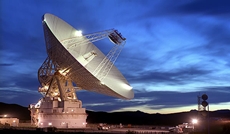NASA finds India’s lost Chandrayaan-1 orbiting Moon
10 Mar 2017
NASA's Jet Propulsion Laboratory (JPL) in Pasadena, California has located two unmanned space crafts, NASA's still-active Lunar Reconnaissance Orbiter (LRO), as well as the Indian Space Research Organisation's Chandrayaan-1 orbiting the Moon.
 NASA's Jet Propulsion Laboratory (JPL) in Pasadena, California has located the Indian Space Research Organisation's (ISRO) lost moon mission Chandrayaan-1 and its own Lunar Reconnaissance Orbiter (LRO), which are still actively orbiting the Moon.
NASA's Jet Propulsion Laboratory (JPL) in Pasadena, California has located the Indian Space Research Organisation's (ISRO) lost moon mission Chandrayaan-1 and its own Lunar Reconnaissance Orbiter (LRO), which are still actively orbiting the Moon.
Chandrayaan-1, India's first lunar probe, launched on 22 October 2008, went silent in 2009 after it lost radio contact. NASA's Lunar Reconnaissance Orbiter (LRO) was launched in 2009.
The JPL in Pasadena, California located two unmanned space crafts using its ground-based radars, NASA said.
As per details by Isro, the satellite made more than 3,400 orbits around the moon and the mission was concluded when the communication with the spacecraft was lost on 29 August 2009. The JPL's calculations indicated that Chandrayaan-1 was circling some 200 kilometres above the lunar surface. Chandrayaan-1, which was difficult to find due to its small size (about 1.5m on each side), had been considered lost after it lost contact in 2009.
DSS-14 is NASA's 70-meter (230-foot) antenna located at the Goldstone Deep Space Communications Complex in California. It is known as the ''Mars Antenna'' as it was first to receive signals from the first spacecraft to closely observe Mars, Mariner 4, on 18 March 1966.
This has been made possible by a new technological application of interplanetary radar pioneered by scientists at NASA's Jet Propulsion Laboratory in Pasadena, California. The radar has successfully located the two spacecraft orbiting the moon - one active, and one dormant.
''We have been able to detect NASA's Lunar Reconnaissance Orbiter [LRO] and the Indian Space Research Organisation's Chandrayaan-1 spacecraft in lunar orbit with ground-based radar,'' said Marina Brozovic, a radar scientist at JPL and principal investigator for the test project. ''Finding LRO was relatively easy, as we were working with the mission's navigators and had precise orbit data where it was located. Finding India's Chandrayaan-1 required a bit more detective work because the last contact with the spacecraft was in August of 2009.''
Add to the mix that the Chandrayaan-1 spacecraft is very small, a cube about five feet (1.5 meters) on each side - about half the size of a smart car. Although the interplanetary radar has been used to observe small asteroids several million miles from Earth, researchers were not certain that an object of this smaller size as far away as the moon could be detected, even with the world's most powerful radars. Chandrayaan-1 proved the perfect target for demonstrating the capability of this technique.
JPL's orbital calculations indicated that Chandrayaan-1 is still circling some 200 kilometers above the lunar surface, but it was generally considered ''lost.''
Radar imagery of the Chandrayaan-1 spacecraft was acquired as it flew over the moon's south pole on 3 July 2016 using NASA's 70-meter (230-foot) antenna at the Goldstone Deep Space Communications Complex in California. This is one of four detections of Chandrayaan-1 from that day.
The team used data from the return signal to estimate its velocity and the distance to the target. This information was then used to update the orbital predictions for Chandrayaan-1.
''It turns out that we needed to shift the location of Chandrayaan-1 by about 180 degrees, or half a cycle from the old orbital estimates from 2009,'' said Ryan Park, the manager of JPL's Solar System Dynamics group, who delivered the new orbit back to the radar team. ''But otherwise, Chandrayaan-1's orbit still had the shape and alignment that we expected.''
Radar echoes from the spacecraft were obtained seven more times over three months and are in perfect agreement with the new orbital predictions.
Hunting down LRO and rediscovering Chandrayaan-1 have provided the start for a unique new capability. Working together, the large radar antennas at Goldstone, Arecibo and Green Bank demonstrated that they can detect and track even small spacecraft in lunar orbit. Ground-based radars could possibly play a part in future robotic and human missions to the moon, both for a collisional hazard assessment tool and as a safety mechanism for spacecraft that encounter navigation or communication issues, NASA said.






























